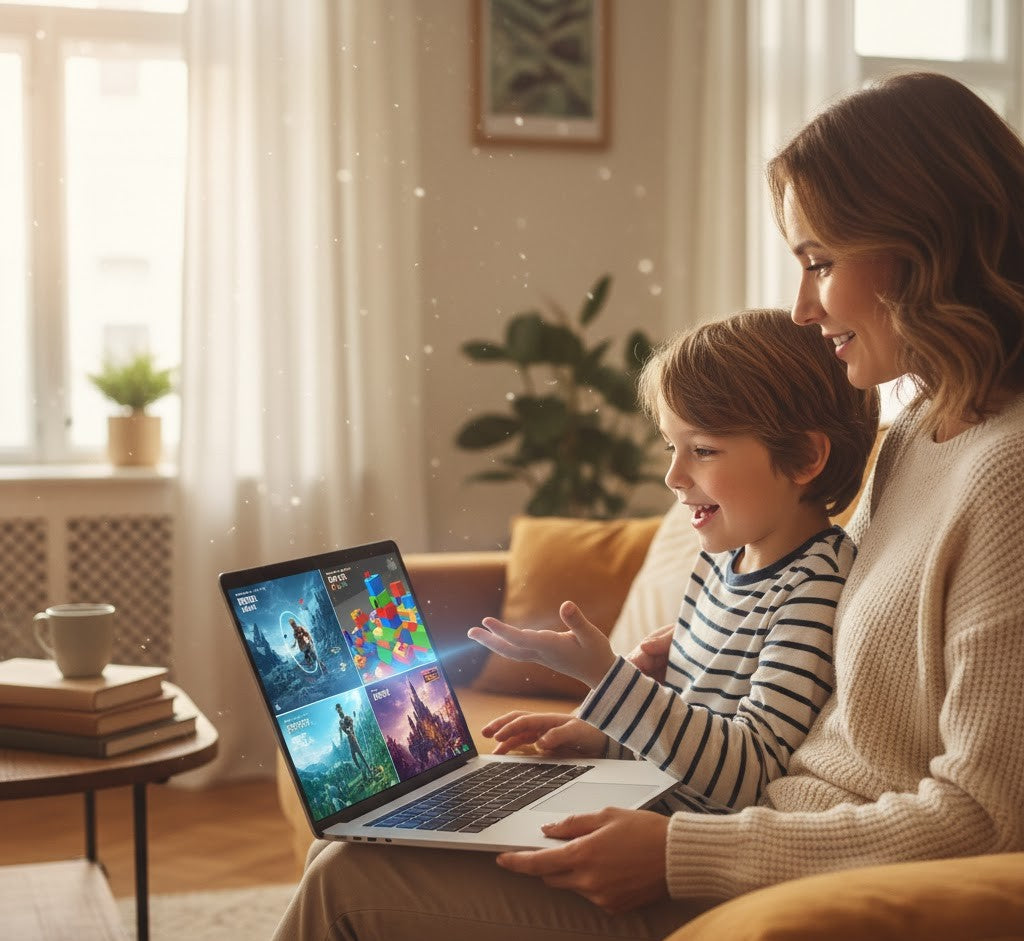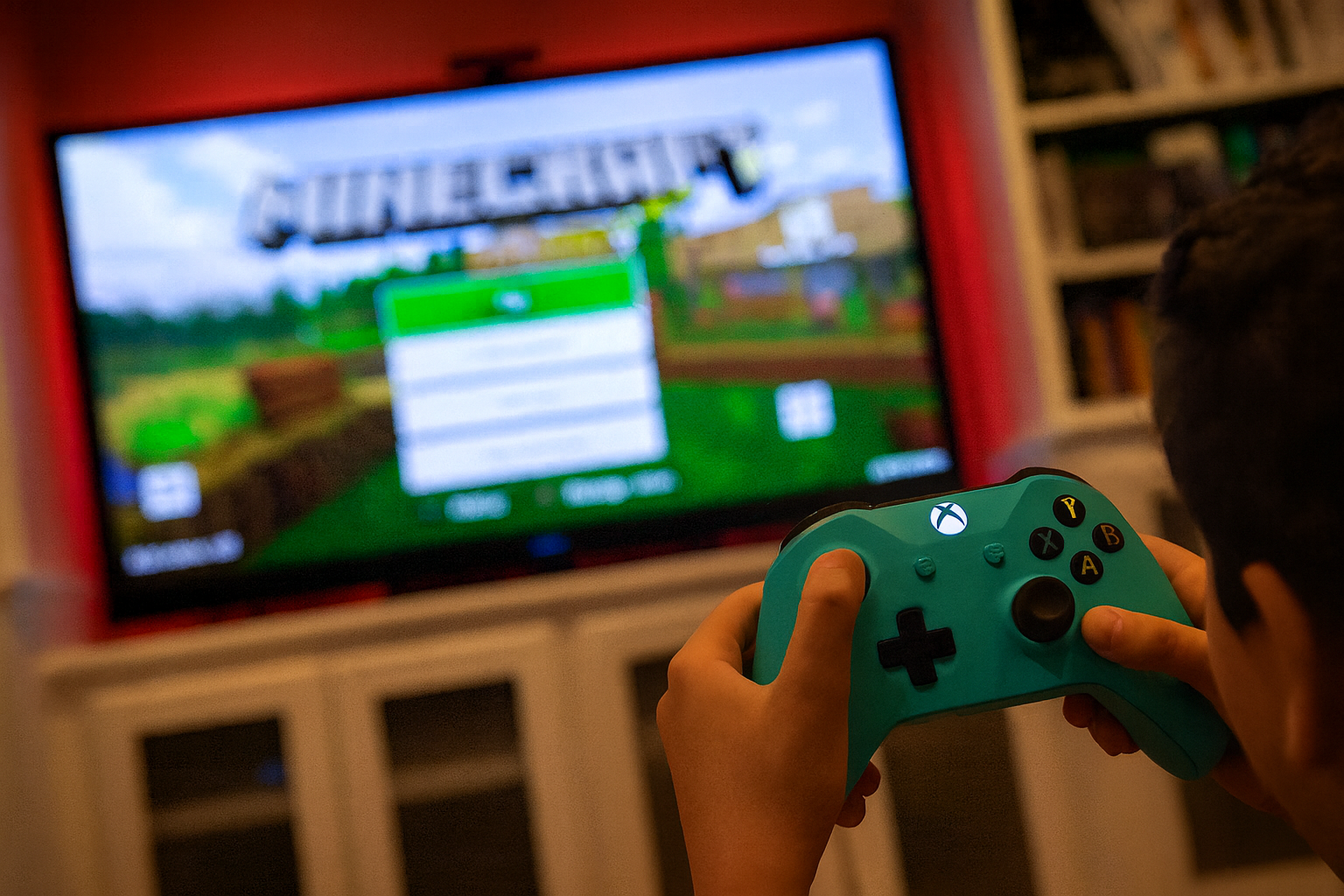The modern parent’s guide to video games
Those of us with a young gamer at home are often at a loss about how to understand kids' gaming habits and how to regulate them. If you frequently have conflicts over screen time, you are not alone.
With the growing popularity of video games among children, many of us could need some help from a parent's guide to gaming. Most of us are unaware of what is going on on the screen exactly, and what gaming means to our kids.
This article will explain online gaming for parents and aims to be the digital parenting guide we all need for support when raising a little gamer. Our goal is to help parents offer the best support for their children's mental health and well-being, and understand their fascination with their gaming hobby.

As long as video games have existed, they have attracted both children and adults. As the internet and gaming devices developed, so did the games. Today’s gaming world has grown beyond just the game on the screen. It has created communities and friendships across borders and elite-level competitions.
Besides movies and video streaming, gaming is often children's first interaction with screens. Many parents let their kids play video games on iPads or gaming consoles before they get a phone or go online. As young gamers get older, many will enjoy gaming online, connecting with other gamers (friends or strangers) worldwide, expanding their digital playground further into cyberspace.
This leaves parents with a need for a parental guide to video games to lean on when it comes to parenting and video games. We need to deepen our understanding of what games and the gaming world are about. Not just to create better rules and boundaries, but to better connect with our child over their hobby. This is why we have collected all our best parenting advice on gaming here to create an ultimate guide to the kids' gaming world.
Understanding the world of online games
Before we dive into how to set rules around gaming, online safety, limiting screen time, etc., we must understand what gaming is for kids and why kids play video games. We might just see gaming as a time-consuming, distracting factor in our child’s life that we are in a constant battle with.
Often, gaming is simply a fun activity and hobby for children that they enjoy just like any other activity. It can be a way for them to have fun with friends, be creative, and practice skills like teamwork and strategic thinking.
But rightfully so, parents still worry about the impact of video games on children. There have been questions about whether video games affect mental health or encourage violent behavior, which is something scholars are still discussing.
However, all video games are not the same, and we should look into the type of games our kids are playing to assess whether they are suitable for our child. If we see our child has an attraction to very violent games or content, or acts aggressively or violently, there could be other factors causing this besides just the game.
We might benefit more from considering our child's circumstances and wellbeing outside the game, and question what is causing this attraction, rather than just blaming the video games.

First, we should consider other factors in their life that might be causing this reaction, as well as consider if the amount of time spent on games makes a healthy and balanced lifestyle possible. Usually, happy and healthy children with a balanced lifestyle will not turn violent over a video game.
But disproportionate time in front of a screen, being overstimulated, or lonely, avoiding problems by escaping into the world of games, can lead to a child acting out. We must consider whether this kind of environment could be part of the reason why we see a link between video games and mental health in a child. In this case, cutting down on gaming alone won’t be enough.
Different types of online games
Kids today play a wide range of video games. Online game genres are constantly evolving, and there are endless types of games to suit all kinds of players of all ages.
Many online games have the option to play with multiple unknown players from all over the world, meeting up online inside the game. This way, you won't always know who you are playing with since everyone hides behind a game character and username.
Games can also be played alone against the computer or with NPCs (non-player characters), or with one or more players, both offline and online. PvP is short for Player vs. Player and describes games where you play against someone else.
The world of gaming has its slang and abbreviations that can be hard for outsiders to keep up with. If you are interested in knowing more about the terminology in gaming, check out this article about basic gaming terminology that’s good for parents to know.
The variety of games includes many different game genres. Many online games draw inspiration from traditional analogue board games, which have been upgraded on the screen. Other games are multiplayer role-playing games that benefit from the infinite possibilities of cyberspace, where only imagination and the newest software set the limits for what is possible.

The list of game genres available is long and still expanding. Here are a few of the common types of online games that kids play today.
Platform games
Platform games are games where the player fights, jumps, or climbs their way through an obstacle course of objects and enemies blocking the way forward. There is usually a clear beginning and end of the game and a finish line to reach. The player has a certain number of lives to use while navigating the dangerous terrain to reach the end of the level. A popular example that has been around for a long time is Nintendo’s Super Mario Bros.
Competing games
Another popular type of game is one that revolves around a match, usually some kind of fighting, shooting, car race, or another sport. Usually, two or more players are competing with each other. But just as often, a single player can be perfecting their scores as they compete against the game to practice their abilities, mastering the discipline of the game.
Survival games
These games are built around surviving in a hostile world or terrain with the help of tactics, strategy, and occasional combat. A battle royal game is an example of a survival game where strategy and teamwork among multiple players play a big role in succeeding. Fortnite and Call of Duty are popular examples.
Interactive games
These games use interactive tools other than just a regular controller or keyboard. This can be a special floor board or a handheld controller registering movement or sound. The goal of these games is to follow instructions on a dance, song, rhythm, or sports discipline to perfect the outcome as much as possible. Here you compete with other players or just have fun singing or dancing by yourself. Popular examples are Just Dance and Guitar Hero.
Puzzle games
These games are based on puzzles, often using logical thinking and visual challenges. The puzzles can involve words, numbers, or shapes, or they can copy traditional analog solitaire games. Tetris and Mahjong are well-known examples among the first simple puzzle video games.
Sandbox games
In this type of game, the player can roam freely in the environment, often with the purpose of building and creating as one pleases. Here, it is not about reaching a specific finish line, goal, or level. There can sometimes be an element of survival, but otherwise, the game is mostly about exploring the world of the game, or building structures or communities.
These games have an element of adventure, exploring unknown territory, and roleplaying aspects of playing a character. Minecraft is one of the most popular sandbox games among children.
A few of the most popular online games for kids:

Identifying unique risks in online gaming
If your child is excited about gaming, there are some online gaming risks to be aware of. Luckily, the dangers of online gaming for kids are not predominant in the gaming experience. However, we still need to consider these risks to ensure gaming is a safe activity for our children to enjoy.
We have collected information about the main pitfalls we should be aware of and know how to handle when our kids are gaming.
1. Communication and conflict
Many online games or gaming platforms have a chat feature where players can chat during the game. Often, it’s used to chat with friends while playing, but kids can also chat with or receive comments from unknown players during a game.
Anywhere kids communicate and interact without supervision, there can be bad language, mean comments, or escalating conflicts. We need to prepare ourselves and our kids for these situations and talk about how to handle online gaming bullying and other forms of toxic behavior in online games to create a safe gaming environment for kids.
What we can do:
- Adjust privacy settings so your child can’t communicate with other players until you feel they are ready and old enough.
- Be aware of in-game communication and check in regularly about how the game went. Misunderstandings or mean comments from a stranger can hit hard.
- Let them know to come to you if they need help with a conflict in the game or with another player.
- Let them know it’s okay to ignore or block anyone who is being mean or disrespectful.
2. Online predators
Unfortunately, many predators seek out their victims online, especially in online spaces where kids hang out unsupervised. Often pretending to be children themselves, they aim to befriend kids through games. Their objective can sometimes be to meet outside the game, or to push for inappropriate conversations or images.
What we can do:
- Make sure your child understands the risk that not everyone is who they say they are online, and sometimes nice people can have bad motives.
- Teach your kids not to chat with or befriend strangers online, or to let you know if they have become friends with someone online.
- Teach kids what to look out for when meeting someone online and to recognize pushy or disrespectful behavior in a chat. Let them know it is okay not to ignore or to block someone who makes them feel uncomfortable by being pushy or inappropriate.
3. Screen time and health
Kids who love gaming often want to play all the time and will push for more game time. Trying to keep a healthy balance can be difficult for kids to do on their own. If the game is safe, spending a long time gaming is not dangerous in itself. But with time, it can be an issue with overstimulation and all the things children don’t do while sitting in front of the computer.
Long hours of inactivity on a daily basis are bad for anyone, but especially for kids who are growing and developing. We need to make sure kids have plenty of time away from the screen to cover their need for exercise and other activities, but also to protect their eyesight and posture from sitting hunched over a screen.
Some kids choose the screen and the gaming world out of boredom or loneliness, or if they have issues in school, with friends, or in the family, they are trying to escape. In this case, the issue is not with the game, but with problems or relationships outside the game.
We also need to be mindful that we don’t use games as babysitters for our kids, creating a bad habit for them and us, robbing them of connection, just to buy ourselves some free time and keep them entertained. Kids need connection and time with family and close relationships, and will often choose this over any game if they can.
What we can do:
- Schedule and keep track of gaming time. Every hobby needs to have boundaries, also gaming, so we also need to set boundaries when it comes to gaming and screen time.
- Make sure our child also does other physical and social activities throughout the day, to keep a balance.
- If you see your child using gaming as an escape from the outside world, the screen is not the issue. Then it’s something deeper, concerning other areas in their life that they need help with.
4. Spending on in-game purchases
Most games offer the opportunity to buy items or access in-game to make the gaming experience even more enjoyable. Games make money this way, and it can be hard for kids to resist the push to make in-game purchases. There can also be an element of comparing to other players having more or better items or features.
What we can do:
Agree on an amount that is okay to spend on virtual items, features, or new levels, and talk about how it’s okay not to have the coolest and most expensive item to impress other players or to enjoy the game. Explain how virtual spendings cost real money.
Choose games with few in-game purchases. Often, games that are initially free will need purchases later on to advance in the game, while games you buy have few or no demands for in-game purchases later on.
Make sure your credit card details are not stored on your child's gaming account after a previous purchase. Many parents learned this the hard and expensive way.
5. Commercial exposure
Free games often consist of many commercial breaks every few minutes. The purpose of those games is mostly to keep the player engaged as long as possible, just to be shown commercials, and not to enjoy a creative or educational gaming experience. For this reason, they can be highly stimulating, building on features that ensure player retention.
What we can do:
- Get familiar with the games your child loves to play, so you know how they are put together and what your child will be exposed to while playing.
- Pause and check before agreeing that they can download a new free app.
- Keep track of screen time and keep it short if your child is playing commercial-filled, repetitive games.

6. Scams
Scams are a risk in any game where there is trading or the collection of valuable virtual items. Scammers are constantly becoming more skilled, and even adults and experienced gamers fall victim to scams. Especially when it comes to trading in internet gaming, safety measures in this area are important to be mindful of.
For kids, it can be a painful and shocking experience to be tricked by someone they trusted, while also losing valuable belongings, even if they are ‘just’ virtual. For children, virtual items in a game can hold a lot of importance, value, and status equal to physical belongings.
What we can do:
Get familiar with advice on how to avoid scams. It is important to talk about the risk of scams, what signs to look out for, and how to avoid them. Go to our guide for parents on everything you need to know about scams in gaming and how to avoid them, for more information on this topic.
Take your child seriously if it happens to them, and be supportive when helping them deal with the situation. Check out our advice on how to support your child if they get scammed.
7. Content and age limits
As parents, we are not always familiar with the games our kids are playing. Many of us let our kids play whatever their friends are playing. But we can’t be sure their friends’ parents are on top of this either. Not all games kids love to play online or on their gaming consoles are for kids.
Besides the opportunity to communicate with strangers, which is not advised for young children, the game content itself can also be unfit for young minds. Some games have graphic violence, scary monsters, or scenery that can haunt kids long after the game is over.
In addition, games with a fast pace, stressful time limits, and flashing pictures can be stressful and overstimulating for anyone to play for longer periods, let alone children. Be aware that the PG game rating is not always set by professionals, but sometimes just rated by the game creators themselves, which, in cases like Roblox, can be any user of the app.
What we can do:
Become familiar with the games your child loves firsthand. Read about them, look over their shoulder, or try a level yourself to see if it’s okay for your child to play. It can vary greatly from parent to parent and from child to child what is considered safe.
Catch up on reviews and information in in-depth online guides like those provided by commensensemedia.org to get detailed information to decide if a game is safe for your child.
Many games have an option for custom settings to adjust the difficulty level, the speed, or how peaceful or scary the game should be, or to disable survival elements. The option to communicate with other players can often be deactivated as well, adjusting the game experience to your child’s age.
8. Gambling elements or temptations
Some games have been criticised for having gambling-like elements. Games can have in-game purchases (like lootboxes, etc) that give access to a potential gain, if you are lucky and receive an item with a much higher value than what you initially paid.
It can be tempting for some kids to speculate on the chance of making money when buying lootboxes at a small cost with the purpose of reselling valuable items.
What we can do:
Be mindful of this risk if our child trades or collects virtual items, so you can address the topic if necessary. Seek out professionals in case of serious issues with gambling.
Talk about the risks and costs of gambling. Explain that it is not a profitable activity that will benefit the player in the long run. Instead, it is meant to tempt the player into spending money on the app or game to profit the game, not the player.
Addressing unhealthy gaming engagement
Most parents of young gamers can agree that managing screen time for kids can be a struggle and often a source of conflict. It is easy to get the feeling that kids would choose to play video games all day if we let them.
In some cases, this can be because, aside from being a fun, social activity, games can be created in a way that purposely retains the attention of the player. In everyday speech, we can be quick to call it addiction and see being captured by a game as a sign of gaming addiction in children, while really, it is a matter of retention and poor habits, boundaries, or agreements around gaming.
Games are stimulating and consume all the player's attention. Releasing oneself from a game and continuing with less stimulating tasks and activities can be difficult for young brains. For some kids, this transition is particularly hard, especially after playing for a long time.
The apathy, tantrums, or frustration displayed in these situations can easily look like signs of gaming addiction. However, it’s more likely a sign that it’s time for a change of gaming habits, and it’s needed to set clear boundaries and help with transition on to a new activity.
Instead of only looking to the struggles we have with keeping healthy habits around gaming, which can be difficult for any child, there are other signs to look for, too, to spot video game addiction.

Video game addiction signs
Here are some questions to ask ourselves to look for gaming addiction in children:
- Does your child want to play less but is unable to, and has had many failed attempts at trying?
- Is gaming, and when they can play again, all they are occupied with? Do they still enjoy other activities too, or are they just focused on when they can go back to gaming, leading to frustration if there are delays or a long time away from the screen?
- Has your child lost interest in other activities they used to love, or stopped spending time with friends or family because of gaming?
- Is the amount of time gaming slowly increasing, while their overall well-being is declining?
- Is your child hiding or lying about how much time they spend on video games?
- Do they turn to gaming for stress relief or as the only way they are able to deal with difficult emotions?
- Do they have strong reactions if they can’t play at a specific time when they normally would, or if they are not able to play video games when stressed or upset?
If this is a picture you recognize, then your child needs qualified help and support, not just stricter screen time rules. Addiction can be about something deeper than just bad habits and lack of rules, and should be treated by a professional health care provider or therapist.
Parents can benefit greatly from the right guidance on how to support their child in this process. Many countries have programs or organisations that offer counseling and help for parents and kids in these situations.
Setting up healthy gaming habits for children
When we have a big gaming fan at home, we must help them develop healthy habits around gaming and screen time. Talking to kids about gaming is the first step to setting gaming limits, and the best way for us to set healthy boundaries.
When we have conversations with our kids about gaming and the games they play, we get a better understanding of what habits and boundaries work for the different games. When our kids feel understood and feel that we care about their hobbies and their perspective, it is much easier to reach an agreement that makes sense to everyone.
But many parents don't know much about gaming or the games their kids play. You might recognize the feeling of being unsure about how to talk to your child about gaming. Often, our attempts at asking about a game are met by our kids with short answers at best, knowing that we probably wouldn't understand anyway if they try to explain. Consequently, our attempts at limiting screen time often fail and miss important details in the game, and are therefore met with resistance and frustration.

Setting clear gaming rules for children
Screen time boundaries for kids are, not surprisingly, tricky for most families and often a source of conflict. The best way to set up video game rules for kids and keep them is to know the game in question.
Screen time rules for children will be more successful if they fit the natural course of the game. Are there levels that create natural stops throughout the game? Or are there big matches between many players that will mark a natural end to the game? Is having a timeframe of 20 minutes to finish the game and any conversations with friends better than a fixed time?
Stopping two minutes before the end of a level or a big match with all your friends will often end in conflict, just as if you were told to end your chess game or football match right before the game was over. Agreeing on what level to stop at or allowing a big match to finish can be helpful when setting rules for a balanced screen time without conflict.
We can also talk with our kids about how many days a week it is okay to be gaming, or for how long? Another approach can also be to insist on having certain chores or activities done before taking time for gaming. Talk with your child about which approach and structure fits them better, and support them in keeping it.
The big game changer is the context in which we view our kids and their activities. Do we view them respectfully as competent individuals involved in, to them, meaningful activities, and with good reasons for their actions? Or do we see them as sneaky and defiant, wasting their time on pointless activities, with no reason to try to understand their choices or reactions?
Kids will often act accordingly. And it is not difficult to imagine ourselves in which of these two circumstances we would be more willing to negotiate and reach an agreement on new habits, if it were us in that situation.
Utilizing parental controls effectively
Parental controls can be an effective tool when setting up game restrictions, healthy boundaries, and habits around gaming for children, and there are different opinions on how to use parental controls.
Parental controls are a great support for the discussions and agreements you have on gaming habits and boundaries. It can be great for setting up appropriate age limits and a framework for safe gaming to protect our kids.
For example, we can make sure that our younger children are not able to be contacted by strangers, while others might need restrictions on making purchases in the game, or being able to freely download apps to their device.
Parental controls can also give the option, together with our child, to track how much time is spent online and on what activities, and based on this, talk about whether any changes are needed.
Engaging with your children about gaming
If our child is all into gaming, we must be careful that we are not only interacting with them in an overly critical manner around their hobby and the time they spend on it. For parent-child bonding, games can be a wonderful way to connect with your child.
Kids love it when we join them in a game and take an interest in their hobbies. This is not just the best way to learn about their favorite game; they will also be forever grateful, and it will make the connection grow stronger.
Maybe you are wondering how to connect with your child over video games, if you don’t see yourself joining them in gaming. If playing video games is not for you, there are still many other ways you can take an interest and join them in exploring their hobby.
You can watch content about gaming on social media, look up tutorials together on their favorite game, or watch while they play and have them explain what the game is about. This will make the parent-child communication on gaming flow more naturally. It will be easier to ask how the game went and keep the conversation going in the future. It will also be a lot easier for them to share their experiences, good or bad, with you.
Think about it, who would you rather go to with any issues or stories from your work? Someone who knows your workplace and colleagues in and out, or someone who knows nothing about it, and on top is critical of your job and the time you spend at work?
Knowing the details about gaming will make it easier for them to come to you if they should ever have some bad experiences. Having the right background information is also the best entry point into educating children on gaming risks and setting fair screen time limits that your child can respect and understand.
To help you out even further, you can try the Raising Digital Citizens toolkit. It includes a set of conversation cards on different topics connected to children's digital life, including gaming. We see them as parent-child bonding cards. The questions teach both parents and children about what’s fun and what’s dangerous online, and allow kids to put their experiences into words. This sets the best foundation for your child’s online safety and healthy digital habits to build on for life.

Creating and managing family screen time rules
Every family wants to be able to successfully enforce healthy habits and screen time rules for kids that last, without power struggles or being a constant source of conflicts. As we see it, there are three effective ways to do this.
First of all, having sufficient information about the game or app that we are creating rules for helps a lot in setting boundaries that make sense to our kids.
Secondly, digital life, apps, habits, and events online must be part of our regular conversations with our kids. If our kids are online, we must keep up with what is happening online as much as in the classroom, the playground, and on playdates.
And third, but probably the most important and effective way to create healthy habits that last, is being role models of the digital habits we want our kids to adopt. Preferably to model these habits even before they get a phone or go online themselves.
Our digital parenting kit ensures all that and puts an end to screen time struggles with kids. Our conversation cards provide a fun framework for learning about your child's digital life and the pitfalls everyone should be aware of.
It’s a great way to connect over your child’s online experiences as you both learn about what digital life is about. The conversations will give everyone in the family the necessary information needed to create a fair and lasting family screen time agreement that will make sense for kids, too.
We have created this Raising Digital Citizens Agreement for you to fill out as a tool to remember all the important things you discussed and the habits you want to keep. Reaching an agreement and understanding on the values and reasons behind your family rules helps in dealing with screen time arguments and managing screen time conflicts in the future.
Positive aspects of gaming
As mentioned earlier, there are also many benefits when it comes to gaming that we must acknowledge, too. All games are different, and they can attract kids for different reasons and teach them different skills.
Some games kids enjoy because they are very social and fun to play with friends, while they are attracted to others because of the strategic or creative challenge they offer. And many genuine friendships have been created between players who only met up online, having conversations far beyond the game.
Some games require complex strategy and planning to complete missions, while others teach social skills and cooperation, because it takes great teamwork to win the game. Other games take place in creative and imaginative universes that spark your imagination and storytelling skills.
Other games draw on problem-solving abilities, or challenge your logical thinking with visually challenging puzzles, while others let you build detailed constructions or machines. Not to mention that most games require math skills, reading, and writing, for some in a foreign language, making it a much more motivating way to learn for some kids.
In addition, there can be advanced technical skills to learn as some games offer elements of coding and programming, and understanding computers on a level that is far beyond the comprehension of most of us, digital immigrants or newbies.
We should be curious about what part of a game attracts your child and what skills they learn playing the game. It will teach us many things about our children's talents and interests and open our eyes to the vast world of gaming.

The educational benefits of gaming
If your child loves gaming, be must be aware of what they spend their time on and help them find and choose good games. There are plenty of educational video games that can be a great way to practice certain skills and offer more motivating ways of learning through gaming.
The benefits of video games in education can be used if there are subjects your child is struggling with in school. It can be easier for some kids to access the material in the form of a video game rather than a book. It might be beneficial if we look for games that strengthen the skills our child needs to practice, or look for school material presented in the form of a video game.
Fostering creativity and social connections
We must also be aware that gaming is not always an activity that kills creativity and creates antisocial children. Many games foster creativity and social connections.
Creative video games for kids encourage creative thinking and stimulate imagination, allowing the players to think outside the box without the limitations of reality.
Multiplayer games for children allow kids to meet up with other players in a game world, where they either play side by side, interact with each other through the game, or cooperate in teams towards a mission or goal.
Kids who struggle with social skills or feel lonely might especially benefit from online social connections to supplement their social life and work on social skills through gaming.
Online relationships should never replace real-life connections, but we should also recognize that, to some kids, online connections can serve as a safe space to be themselves and help them through a difficult time.
Supporting parents in the digital age
With today's children living life online and using technology in many different ways, many of us understandably have growing parental concerns about technology.
Digital parenting might cause us stress, and some experience anxiety over managing screen time. This is why we have created Raising Digital Citizens to support parents in this digital age in raising confident and competent children, online and offline.
Managing digital parenting challenges
On a general note regarding any kind of digital use, many of us are struggling with balancing technology and family life and setting tech boundaries at home. Keeping healthy habits is a challenge not just for our kids but also for ourselves.
To keep digital discipline, strategies of different kinds are needed. There are many approaches to take to reduce screen time and stay aware of online dangers, and our kids’ online hobbies. Keeping a close connection and open communication with our kids, is by far the most effective way to keep kids safe and agree on healthy digital habits, and keep them.
Useful resources for parental guidance
Being new to the digital world that our kids grow up in, it is understandable that we won’t have all the answers ourselves and can find it challenging to raise these young digital citizens.
Luckily, there is a lot of information and advice available for parents to draw on for guidance.
Parental control tools can be a great support for creating a safe framework for your child’s online experiences. Technology guides for families can teach the basics about the apps, games, and devices kids use.
But the best online safety resources for parents lie in establishing trusting relationships and close connections with our kids, and a habit of talking about everything happening online.

Conclusion: empowering parents to navigate the gaming world
Hopefully, this article has contributed as guidance to parents wanting to know how to support their child who games and as a piece of parental empowerment in the digital age.
Helping kids build good gaming habits and teaching kids responsible gaming starts with us. If we start with educating ourselves about the games our kids play, look into parenting tips for video games, learn why our kids love them, and join them once in a while for a game, we have already come far.
Navigating children's online activities is much easier when we have firsthand experiences ourselves and know a bit about their online life. Besides strengthening the bond and connection with our kids, when we take an interest in their hobbies, it also gives the best foundation for setting meaningful rules and boundaries around gaming together for the future.





